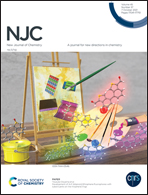Dielectric analysis of the percolation, interface polarization, and phase behavior of 1-butyl-3-methylimidazolium tetrafluoroborate/TX-100/triethylamine microemulsions†
Abstract
The dielectric properties of nonaqueous microemulsions of 1-butyl-3-methylimidazolium tetrafluoroborate ([bmim][BF4])/p-(1,1,3,3-tetramethylbutyl)phenoxypolyoxyethyleneglycol (TX-100)/triethylamine, in which the ionic liquid (IL) serves as the polar phase, were measured as a function of IL weight fraction over the frequency range from 1 MHz to 3 GHz. One dielectric relaxation at approximately 100 MHz was observed in these samples. Dielectric parameters for this relaxation, namely, the relaxation time and dielectric increment, were obtained by fitting the dielectric spectra with one Cole–Cole term formula. Two inflection points were observed for the weight fraction dependence of these dielectric parameters, which correspond to the phase boundaries between the IL-in-oil (IL/O), bicontinuous (B.C.) and oil-in-IL (O/IL) subregions. We found that in this hydrophilic IL-based microemulsion static percolation occurs near the critical threshold between the IL/O and O/IL subregions. This conclusion is inferred based on four different methods, namely, the scaling dependences of the direct-current (DC) conductivity and static dielectric constant on the IL weight fraction, the scaling dependence of permittivity on frequency and the dependence of the loss angle on frequency. The relaxation mechanism is identified as interfacial polarization, which is supported by good agreement between the values obtained for relaxation times from experiment and those calculated from Maxwell–Wagner theory. In addition, analysis of the phase parameters calculated by Hanai theory indicates that IL/O microdroplets not only contain the IL but also include TX-100 molecules (whose volume fraction is also calculated), and the continuous phase for the O/IL subregion should be an IL/TX-100 binary solvent rather than the pure IL. These phenomena indicate that the interaction between the IL and TX-100 is closer than that between TX-100 and the oil.



 Please wait while we load your content...
Please wait while we load your content...